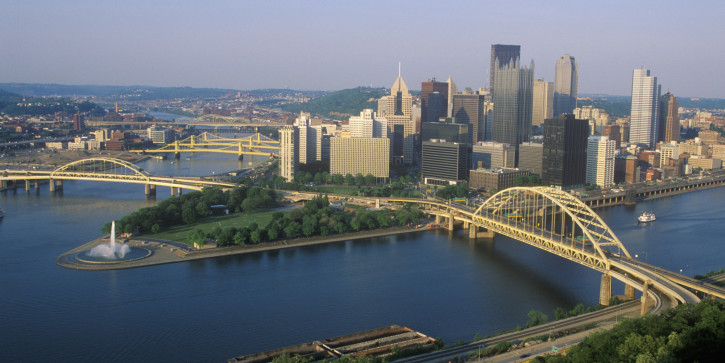
As research for an upcoming paper China’s Next Opportunity: Sustainable Economic Transition, the Paulson Institute has been talking to experts from America’s rust belt cities. We’ve been asking about what contributed (or didn’t) to the revitalization of places such as Pittsburgh, Cleveland and Toledo. As China shifts away from investment- and infrastructure-led economic growth, the Jing-Jin-Ji region—and especially Hebei province, the country’s largest steel-manufacturing region, producing 28% of all of China’s steel in 2014—is going through an experience similar to that of America’s rust belt beginning in the 1970s: less demand, reduced production, job loss, leading to soul searching for potential reinvention. Here’s some of what the experts had to say:
 Could Pittsburgh’s revitalization have happened without a cleaner and more attractive environment?
Could Pittsburgh’s revitalization have happened without a cleaner and more attractive environment?
 Karen Clay (Associate Professor of Economics, Carnegie Melon University): Pittsburgh’s revitalization absolutely could not have happened without the cleanup. Even with the cleanup, Pittsburgh still has mild air quality issues because of geography, but its air quality continues to improve as coal plants shut down in favor of natural gas. Water quality continues to improve too. And there has been substantial investment in amenities like riverside parks and biking trails.
Karen Clay (Associate Professor of Economics, Carnegie Melon University): Pittsburgh’s revitalization absolutely could not have happened without the cleanup. Even with the cleanup, Pittsburgh still has mild air quality issues because of geography, but its air quality continues to improve as coal plants shut down in favor of natural gas. Water quality continues to improve too. And there has been substantial investment in amenities like riverside parks and biking trails.
 Jim Russell (Research Fellow, Center for Population Dynamics at Cleveland State University): The immediate impact of sustainability and environmental quality on the economy relates to health and worker productivity. That said, the larger benefit of cleaning up the environment is that the narrative of a place changes, and that underpins economic changes. If residents or outsiders see a dirty city, they see a hopeless city. If you can change the psychology of the city so that the residents feel it is worth defending and changing, that is valuable.
Jim Russell (Research Fellow, Center for Population Dynamics at Cleveland State University): The immediate impact of sustainability and environmental quality on the economy relates to health and worker productivity. That said, the larger benefit of cleaning up the environment is that the narrative of a place changes, and that underpins economic changes. If residents or outsiders see a dirty city, they see a hopeless city. If you can change the psychology of the city so that the residents feel it is worth defending and changing, that is valuable.
 What mistakes did city leaders make over the years in revitalizing Rust Belt cities?
What mistakes did city leaders make over the years in revitalizing Rust Belt cities?
 Sabina Deitrick (Associate Professor, Graduate School of Public and International Affairs at the University of Pittsburgh): I would point to the overall slowness of some of the revitalization strategies. This slowness was due to political leaders wanting to protect jobs in older industries. In Pittsburgh, top economists reported in the 1960s that the city would have to change directions, but the leadership wasn’t willing to listen. Steel was the name of the game, even when it was already shrinking. The same was true in Detroit, where leaders tended to view any downturn as merely a part of the auto sector’s boom and bust cycle.
Sabina Deitrick (Associate Professor, Graduate School of Public and International Affairs at the University of Pittsburgh): I would point to the overall slowness of some of the revitalization strategies. This slowness was due to political leaders wanting to protect jobs in older industries. In Pittsburgh, top economists reported in the 1960s that the city would have to change directions, but the leadership wasn’t willing to listen. Steel was the name of the game, even when it was already shrinking. The same was true in Detroit, where leaders tended to view any downturn as merely a part of the auto sector’s boom and bust cycle.
 Jim Russell: The biggest mistake is an abstract one, namely the idea that there is some sort of local policy that can fix things. This is hubris. City leaders often don’t pay attention to the vast macroeconomic forces that are really driving what’s going on in their city. Political figures and public-private partnerships often try launching big capital projects to stop the “brain drain”—the departure of more educated residents—spending the region’s tax money on airports, convention centers, light rail, or stadiums. Instead, they should spend money on basic research, pick a technology cluster and establish targets, like Texas went after cancer research and began poaching cancer researchers from other regions. It’s a winning restructuring technique.
Jim Russell: The biggest mistake is an abstract one, namely the idea that there is some sort of local policy that can fix things. This is hubris. City leaders often don’t pay attention to the vast macroeconomic forces that are really driving what’s going on in their city. Political figures and public-private partnerships often try launching big capital projects to stop the “brain drain”—the departure of more educated residents—spending the region’s tax money on airports, convention centers, light rail, or stadiums. Instead, they should spend money on basic research, pick a technology cluster and establish targets, like Texas went after cancer research and began poaching cancer researchers from other regions. It’s a winning restructuring technique.
Aaron Renn, Senior Fellow, Manhattan Institute for Policy Research: The number one issue that I see is that urban leaders don’t handle urban planning and urban issues in a strategic way. Cities like Cleveland, Toledo, Pittsburgh and Chicago are all radically different places, but the solution set that academics or leaders propose is always or often the same.
Stay tuned for more on this topic in our upcoming paper China’s Next Opportunity: Sustainable Economic Transition coming out in October.




